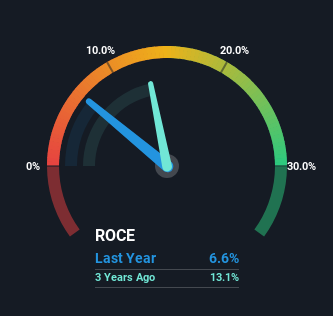
What trends should we look for it we want to identify stocks that can multiply in value over the long term? Firstly, we'd want to identify a growing return on capital employed (ROCE) and then alongside that, an ever-increasing base of capital employed. Basically this means that a company has profitable initiatives that it can continue to reinvest in, which is a trait of a compounding machine. In light of that, when we looked at Watanabe Sato (TSE:1807) and its ROCE trend, we weren't exactly thrilled.
What Is Return On Capital Employed (ROCE)?
If you haven't worked with ROCE before, it measures the 'return' (pre-tax profit) a company generates from capital employed in its business. Analysts use this formula to calculate it for Watanabe Sato:
Return on Capital Employed = Earnings Before Interest and Tax (EBIT) ÷ (Total Assets - Current Liabilities)
0.066 = JP¥1.6b ÷ (JP¥34b - JP¥9.5b) (Based on the trailing twelve months to December 2023).
So, Watanabe Sato has an ROCE of 6.6%. In absolute terms, that's a low return but it's around the Construction industry average of 7.6%.
View our latest analysis for Watanabe Sato

Historical performance is a great place to start when researching a stock so above you can see the gauge for Watanabe Sato's ROCE against it's prior returns. If you'd like to look at how Watanabe Sato has performed in the past in other metrics, you can view this free graph of Watanabe Sato's past earnings, revenue and cash flow.
So How Is Watanabe Sato's ROCE Trending?
When we looked at the ROCE trend at Watanabe Sato, we didn't gain much confidence. To be more specific, ROCE has fallen from 9.5% over the last five years. However it looks like Watanabe Sato might be reinvesting for long term growth because while capital employed has increased, the company's sales haven't changed much in the last 12 months. It's worth keeping an eye on the company's earnings from here on to see if these investments do end up contributing to the bottom line.
On a side note, Watanabe Sato has done well to pay down its current liabilities to 28% of total assets. That could partly explain why the ROCE has dropped. Effectively this means their suppliers or short-term creditors are funding less of the business, which reduces some elements of risk. Some would claim this reduces the business' efficiency at generating ROCE since it is now funding more of the operations with its own money.
The Key Takeaway
Bringing it all together, while we're somewhat encouraged by Watanabe Sato's reinvestment in its own business, we're aware that returns are shrinking. Yet to long term shareholders the stock has gifted them an incredible 111% return in the last five years, so the market appears to be rosy about its future. However, unless these underlying trends turn more positive, we wouldn't get our hopes up too high.
If you want to know some of the risks facing Watanabe Sato we've found 2 warning signs (1 shouldn't be ignored!) that you should be aware of before investing here.
If you want to search for solid companies with great earnings, check out this free list of companies with good balance sheets and impressive returns on equity.
Valuation is complex, but we're here to simplify it.
Discover if Watanabe Sato might be undervalued or overvalued with our detailed analysis, featuring fair value estimates, potential risks, dividends, insider trades, and its financial condition.
Access Free AnalysisHave feedback on this article? Concerned about the content? Get in touch with us directly. Alternatively, email editorial-team (at) simplywallst.com.
This article by Simply Wall St is general in nature. We provide commentary based on historical data and analyst forecasts only using an unbiased methodology and our articles are not intended to be financial advice. It does not constitute a recommendation to buy or sell any stock, and does not take account of your objectives, or your financial situation. We aim to bring you long-term focused analysis driven by fundamental data. Note that our analysis may not factor in the latest price-sensitive company announcements or qualitative material. Simply Wall St has no position in any stocks mentioned.
About TSE:1807
Watanabe Sato
Engages in the contracting and investigation, research, planning, designing, supervision, technical guidance, and consultation of civil engineering construction activities.
Established dividend payer with adequate balance sheet.
Market Insights
Community Narratives




